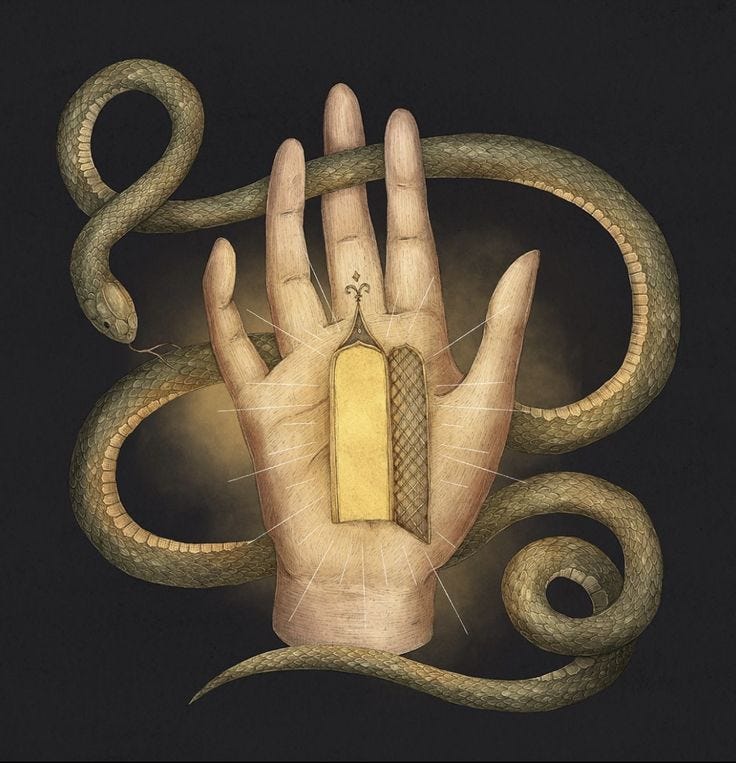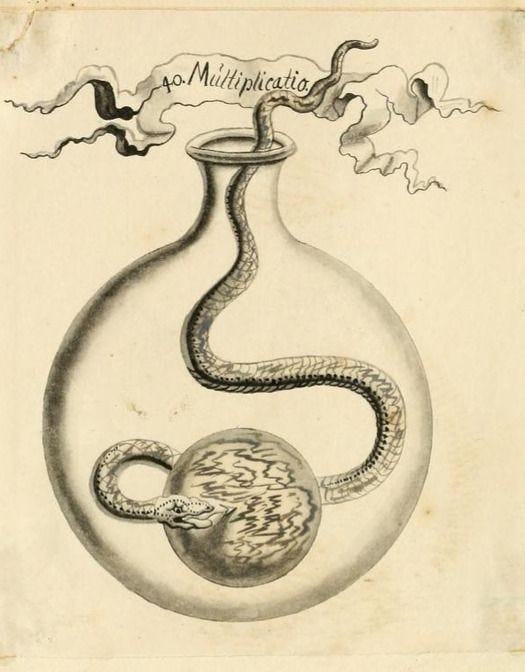December Subscriber Post
2024 in Review, Gnosticism, and the geometry of the Fall of Adam
It has been a good year here on Vectors of Mind. The Eve Theory of Consciousness has always been aspirational. Pedantically, it’s more of a hypothesis—particularly versions 1 and 2. However, with the third version, it has the flavor of a full-blown theory. A lot of the uncertainty about the model and supporting evidence is ironed out. If you haven’t read it, I’m not sure what you’re doing here. Some complain that it’s long. But it’s much shorter than books in the genre, all while packing in more information. You can even listen to it, thanks to Askwho Casts AI:
The algorithms that be have smiled upon EToC, particularly in the last month, in which time there have been 60 new “shares” alone (itshappening.gif). I’m getting followers who say the Substack App has been recommended EToC to them several times throughout the year, and they finally took the hint and read it. Substack is extremely good at finding people who would like to read a 30,000-word essay on the evolution of consciousness.
You can help a great deal by sharing the post (even privately1), signaling to Substack that this is worth reading to people like yourself. I don’t spend much time asking people to “like and subscribe,” but this is a leveraged moment when the algorithm is taking notice, and these things have exponential feedback loops.
There are two other articles from 2024 that I strongly recommend reading. The first is Pygmy Eve Peeps God which explores the Pygmy creation myth. It is extremely similar to what is found in Genesis, with the major difference being the forbidden fruit Eve partakes in seeking out God. Facts tend only to be surfaced by those with a framework they support. It is a good sign for my theory that so many creation myths support it. But even beyond supporting EToC, I’m glad I could surface stories that are given short shrift, even by those who one would think would be interested. (I’m shocked nobody in the Jaynesian world has found this story; it’s a better model of bicameral breakdown than Genesis.)
The second is When Do Geneticists Believe the Human Brain Evolved? which covers a landmark paper that shows strong selection on cognitive ability in the last 10,000 years. I don’t see how one can get around meta-cognition—or language or whatever the human special sauce was—being useful. If an ability is useful, there will be selection. That’s what we observe in the last 10,000 years. If we project similar rates of evolution back 20,000 or 100,000 years, we are clearly in “phase change” territory. That is, if humans were gaining an IQ point every 100 or 500 years, this quickly adds up to mean humans in the distant past would have very low IQ. As in, pre-linguistic or pre-recursive IQ2. If the human special sauce evolved in the last 50,000 or 100,000 years, then the genetics and archeology would look about like what we observe. Arguments that there has been no evolution in that time frame or that there is no special sauce are driven by ideological desire for a blank slate. I discuss this with Stetson (who disagrees) in this podcast.
Going forward, I have a couple of bigger articles in the works—a two-year retrospective on the Snake Cult, and an exploration of those who profane the mysteries. I also want to produce smaller VoM-shaped tidbits more regularly (this two-minute read was a crowd favorite).
This Month on Vectors of Mind
Review of articles this year (on Notes):
Appearances elsewhere:
Nick Jikomes of Mind & Matter has a Ph.D. in Neuroscience and a B.S. in Genetics. On M & M, he has interviewed hundreds of scientists, dozens of whom research human evolution. He asks excellent questions, and since this aired, there has been an influx of science-minded subscribers. I’m looking for more opportunities like this, so if you listen to a podcast I should be on, let them know in the comments!
My bullroarer piece was covered by Tom Chivers in the London Review of Substacks
Links
Roger’s Bacon has a great series on Gnosticism:
Andres Gomez Emilsson of Qualia Research Institute discusses the Fall in terms of geometry and waves:
It's like the original sin could now be seen as symmetry breaking, that moment of the first imbalance. That pinch point is the original asymmetry.
We spend our whole lives trying to deal with and compensate for that. It's really interesting—this sense of primordial guilt that Christianity talks about, which I think a lot of people feel. It doesn't seem to me like it's just something culturally implemented. It feels like it runs deeper, something almost inherent.
Daniel Ingram's idea of original sin as this sense of guilt tied to that original fracturing is fascinating—and a little spooky. How does that even work? It’s like, "I feel guilty for having separated myself from the field."
From time mark 1:29:00:
He also makes predictions about the future:
There’s a deep connection between being whole, being unified, and feeling good. It’s like the universe doesn’t like to separate from itself.
I’m optimistic that there are states of what I’d call "super sanity." No human can access them right now, but from the perspective of our descendants, we’re probably in a constant state of super psychosis—on multiple levels. Like, ten levels of psychoticism.
Not just because we think we’re individual entities, but also because our entire understanding of concepts like time, space, and how valence fits into the picture is completely off. It’s psychotic.
I suspect there are states of consciousness where it all makes sense—where you can fully understand why there’s something rather than nothing, or why valence exists and how it functions. These would be states of "super understanding," but we’re just not there yet.
What happens once we return to that state? The thing is, it might be impossible to avoid.
Alfredo Parra, his colleague at QRI, has a good post on cluster headaches in the Effective Altruism Forum.
Feeling the AGI
OpenAI closed their 12 days of Christmas by announcing o3, a language model which takes time to “think” as it solves problems, and which obtained human-level performance on the ARC-AGI benchmark, which has been the go-to example of what AI cannot solve. François Chollet, the ML scientist who made the benchmark, speculates on what this means and how it was accomplished:
“o3's improvement over the GPT series proves that architecture is everything. You couldn't throw more compute at GPT-4 and get these results. Simply scaling up the things we were doing from 2019 to 2023 – take the same architecture, train a bigger version on more data – is not enough. Further progress is about new ideas.
…
To adapt to novelty, you need two things. First, you need knowledge – a set of reusable functions or programs to draw upon. LLMs have more than enough of that. Second, you need the ability to recombine these functions into a brand new program when facing a new task – a program that models the task at hand. Program synthesis. LLMs have long lacked this feature. The o series of models fixes that.”
This is big news, and Chollet’s analysis is the best I’ve seen. He makes the case that o3 uses the same algorithm that DeepMind used for AlphaGo.
Miles Brundage also has a nice recap, with more focus on policy/action:
AI Notkilleveryoneism Memes is, as the name suggests, an account concerned with the impending AI apocalypse. I’m on record staking out an anti-doom position (at least regarding existential risk), but I enjoy this account. Here they post an interesting thread of advertising around SF urging people not to hire humans:
However, their memes are usually more inside baseball:
Agents can simulate people with 2 hours of conversation. It is over for us podcasters.
The Land Down Under
Mungo Manic is an account on X that consistently posts high-quality, hard-to-find content about Aboriginal Australians. He’s an autodidact doing it for the love of the game, so he is much more playful (and truth-seeking) than you usually get when someone ends up so far in the weeds. Grey Goose Chronicles even had him on to give a guest post:
Two articles on the Acacia tree, which is referenced in a surprising number of traditions. The Arc of Covenant was made out of Acacia, as were bullroarers in Australia. Interestingly, the wood is a good source of DMT. There is a fight for whether the tree is considered indigenous to South Africa or Australia. Those first two links are to Medium, but the author (Mike Co) looks to be starting a Substack.
YouTube
In Consequences of Conscience I wrote:
“The next post will examine what selection pressure may have caused the bicameral mind to break down and when that may have happened. The result is our modern mind-space, all too capable of rumination. For me, one of the most remarkable realizations has been that our inner voice may be downstream of our ancestors trying to follow the Golden Rule. “I” may have emerged in an attempt to model the minds of others.”
This is the realization that set me down the snake cult rabbit hole. Scott Alexander has an essay, beautifully animated, that also plays with the tension between Darwin and altruism.
Classicist Carl Ruck in an insightful interview on the role of psychedelics in philosophy. He thinks the Elusinian Mysteries are versions of rituals practiced in Ice Age Europe 15,000+ years earlier, going so far as to say Plato’s Cave is part of the tradition of using caves as temples (before temples even existed). I’d like to learn more about how Axial Age philosophy grew out of the received Snake Cult myths, something I briefly touched on in my review of Brian Muraresku’s Immortality Key. In the episode, Ruck also discusses snake venom as an entheogen.
Hank Greene lost his inner monologue in his 20s:
Best lecture on personality out there:
Werner Herzog, gentle as always: “Psychologists are a disease of our time. They should all just be put on an airplane and flown into an island in the Pacific. They should analyze each other but they should not bother us.”
Bufo Toad venom is considered by many to be the best psychedelic (5meo-DMT). I didn’t realize that it was only discovered in the 1980s, and its use can be traced back to a single pamphlet. Vice even resurrected John Lennon to be the face of the documentary:
Alt-doc crew Channel 5 News on snake churches in the USA:
Of note, the interviewer, Andrew Callaghan, has Hallucinogen Persisting Perception Disorder (HPPD), a condition that causes lingering visual and perceptual changes from prior psychedelic use. He has discussed this feeling of unreality as part of why he tries to find the strangest parts of society. The curiosity works for his interviews.
What else will people find interesting? Let us know in the comments.
Substack tracks this if you hit the “share” icon at the top and bottom of any article.
Don’t get hung up on “IQ” as particularly relevant to the special sauce. I use it because that is the phenotype for intelligence the paper uses. I’m on the record saying EQ > IQ, especially regarding human evolution.
















